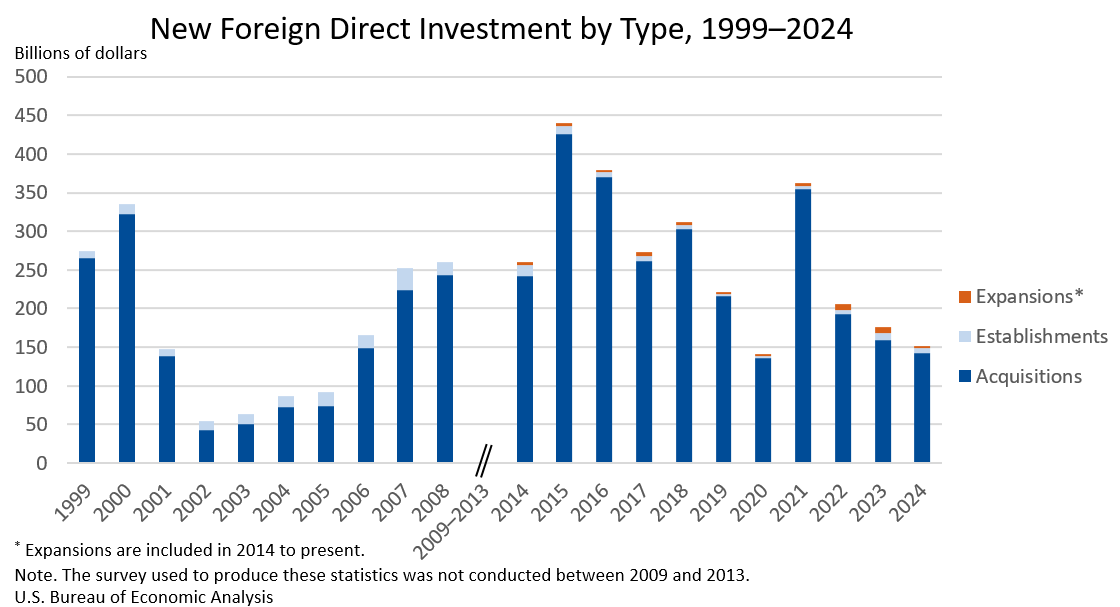Bureau of Economic Analysis
New Foreign Direct Investment in the United States, 2024
Expenditures by foreign direct investors to acquire, establish, or expand U.S. businesses totaled $151.0 billion in 2024, according to preliminary statistics released today by the U.S. Bureau of Economic Analysis. Expenditures decreased $24.9 billion, or 14.2 percent, from $176.0 billion (revised) in 2023 and were below the annual average of $277.2 billion for 2014–2023. As in previous years, acquisitions of existing U.S. businesses accounted for most of the expenditures.
Principal Federal Economic Indicators
Noteworthy
- 2025 News Release Schedule
- Innovation at BEA
- 2025 Annual Updates
- New! Services Trade Data for More Countries
- Data Tool: Trade in Value Added
- Distribution of State Personal Income
- Updated: RIMS II Regional Multipliers
- Arts and Culture
- Space Economy
- FDI Now in State BEARFACTS
- Quick Guide: Price Indexes
The Latest
Personal Consumption Expenditures by State, 2019
State personal consumption expenditures (PCE) increased 3.9 percent in 2019, a deceleration from the 4.9 percent increase in 2018. The percent change in PCE across all states ranged from 5.7 percent in Utah to 1.8 percent in Vermont.
Personal Consumption Expenditures by State, 2019
State personal consumption expenditures (PCE) increased 3.9 percent in 2019, a deceleration from the 4.9 percent increase in 2018. The percent change in PCE across all states ranged from 5.7 percent in Utah to 1.8 percent in Vermont.
August 2020 Trade Gap is $67.1 Billion
The U.S. monthly international trade deficit increased in August 2020 according to the U.S. Bureau of Economic Analysis and the U.S. Census Bureau. The deficit increased from $63.4 billion in July (revised) to $67.1 billion in August, as imports increased more than exports. The previously published July deficit was $63.6 billion. The goods deficit increased $3.0 billion in August to $83.9 billion. The services surplus decreased $0.7 billion…
U.S. International Trade in Goods and Services, August 2020
The U.S. monthly international trade deficit increased in August 2020 according to the U.S. Bureau of Economic Analysis and the U.S. Census Bureau. The deficit increased from $63.4 billion in July (revised) to $67.1 billion in August, as imports increased more than exports. The previously published July deficit was $63.6 billion. The goods deficit increased $3.0 billion in August to $83.9 billion. The services surplus decreased $0.7 billion in…
Gross Domestic Product by State, 2nd Quarter 2020
Real gross domestic product (GDP) decreased in all 50 states and the District of Columbia in the second quarter of 2020, as real GDP for the nation decreased at an annual rate of 31.4 percent. The percent change in real GDP in the second quarter ranged from –20.4 percent in the District of Columbia to –42.2 percent in Hawaii and Nevada.
Gross Domestic Product by State, 2nd Quarter 2020
Real gross domestic product (GDP) decreased in all 50 states and the District of Columbia in the second quarter of 2020, as real GDP for the nation decreased at an annual rate of 31.4 percent, according to statistics released today by the U.S. Bureau of Economic Analysis. The percent change in real GDP in the second quarter ranged from -20.4 percent in the District of Columbia to -42.2 percent in Hawaii and Nevada.
Personal Income and Outlays, August 2020
Personal income decreased 2.7 percent while consumer spending increased 1.0 percent in August, according to estimates released today by the Bureau of Economic Analysis.
Personal Income and Outlays, August 2020
Personal income decreased 2.7 percent while consumer spending increased 1.0 percent in August, according to estimates released today by the Bureau of Economic Analysis.
Gross Domestic Product (Third Estimate), Corporate Profits (Revised), and GDP by Industry, Second Quarter 2020
Real gross domestic product (GDP) decreased at an annual rate of 31.4 percent in the second quarter of 2020, according to the “third” estimate released by the Bureau of Economic Analysis. The change was 0.3 percentage point higher than the “second” estimate released in August. In the first quarter of 2020, real GDP decreased 5.0 percent. For more details, including source data, see the Technical Note. Second-quarter GDP highlights
Gross Domestic Product (Third Estimate), Corporate Profits (Revised), and GDP by Industry, Second Quarter 2020
Real gross domestic product (GDP) decreased at an annual rate of 31.4 percent in the second quarter of 2020, according to the “third” estimate released by the Bureau of Economic Analysis. The change was 0.3 percentage point higher than the “second” estimate released in August. In the first quarter of 2020, real GDP decreased 5.0 percent.




